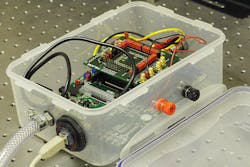FLUORESCENCE SENSORS: Lunchbox-sized fluorescence sensor detects explosive vapors
To detect security threats such as the nitroaromatic explosive trinitrotoluene (TNT), vapor-detection sensitivities of parts per billion (ppb) are required—and preferably detected using a compact instrument that is easily transported to the threatened location. Using a microsystem based on a chemosensory conjugated (semiconducting) polymer, a team of Scottish researchers from the University of St. Andrews (Fife), University of Edinburgh (Edinburgh), and the University of Strathclyde (Glasgow) has developed a lunchbox-sized explosive-vapor sensor that can detect 10 ppb concentrations of dinitrobenzene (DNB) vapor (a nitroaromatic simulant for TNT).1
Fluorescence quenching
Typical fluorescence-based sensing techniques measure a reduction in the light intensity from a photoemissive material due to fluorescence quenching of the material by the vapor under test; that is, photoexcitation of an electron-rich conjugated polymer is followed by electron transfer to an explosive vapor that occupies a lower-energy molecular orbital than the polymer, causing fluorescence quenching and reduced light emission from the polymer. Because measuring reductions in photoluminescence, amplified spontaneous emission (ASE), and lasing from this quenching action are all impacted by internal and external environmental factors such as excitation intensity, collection efficiency, and stray light, the research team chose to measure the vapor analyte by quantifying the change in photoluminescence lifetime of the polymer lasing material.
Photoluminescence lifetime or time-resolved fluorescence is readily measured using conventional time-correlated single-photon-counting (TCSPC) techniques. But rather than using commercially available TCSPC instruments, a complementary metal-oxide semiconductor (CMOS)-based system was used in combination with an array of nitride light-emitting diodes (LEDs) to excite fluorescence and then detect it using silicon CMOS single-photon avalanche diodes (Si-CMOS SPADs) to reduce system costs and physical size.
CMOS-based detection
The lunchbox-sized detection system consists of the polymer sensor—a thin film of commercially available Cambridge Display Technology (Cambridgeshire, England) green (CDTG) fluorene-based copolymer on a fused-silica substrate—and a CMOS-driven LED array excitation source, photodetector, and fluorescence-lifetime signal-processing circuitry (see figure).
An 8 × 8 array of aluminum-indium-gallium-nitride (AlInGaN) micro LEDs with 72-μm-diameter pixels produced the 450-nm-peak-excitation, 1.2-ns pulsewidth illumination that impinges on the polymer sensor. A second CMOS chip includes a 16 × 4 array of SPADs with on-chip timing and signal-processing circuits. A 514 nm long-pass filter is inserted just between the polymer sensor and the SPAD chip to eliminate residual excitation.
Using a time-gate width of approximately 460 ps, the photon count values due to fluorescence emissions from the thin-film sensor in the presence of an explosive vapor are measured and used to build a histogram of the fluorescence decay curve. A rapid lifetime determination (RLD) algorithm is alternatively used to make fluorescence-lifetime measurements in 15 s. Because the system is programmed to take 20 RLD measurements continuously, lifetime changes can be observed in near real time. Measurements of fluorescence lifetime were 2.66 ns before exposure to a 10 ppb DNB analyte and 1.63 ns after exposure—a 36% lifetime reduction that was consistent with control measurements made using commercially available TCSPC instruments.
“This compact sensor was developed within the EPSRC-funded HYPIX research collaboration, which is working to develop hybrid GaN/organic optoelectronic microsystems integrated to CMOS,” says University of St. Andrews lecturer Graham Turnbull. “By integrating together different semiconductor technologies we can create novel microsystems that offer a new approach to explosive vapor detection. The sensor microsystem detects vapors of TNT-like materials, which are a major component of landmines. Currently the work is at a laboratory proof-of-principle stage, but we would like to advance this laboratory prototype towards applications in landmine detection.”
REFERENCE
1. I.D.W. Samuel et al., SPIE Optics & Photonics conference paper 8118-13, San Diego, CA (Aug. 25, 2011).

Gail Overton | Senior Editor (2004-2020)
Gail has more than 30 years of engineering, marketing, product management, and editorial experience in the photonics and optical communications industry. Before joining the staff at Laser Focus World in 2004, she held many product management and product marketing roles in the fiber-optics industry, most notably at Hughes (El Segundo, CA), GTE Labs (Waltham, MA), Corning (Corning, NY), Photon Kinetics (Beaverton, OR), and Newport Corporation (Irvine, CA). During her marketing career, Gail published articles in WDM Solutions and Sensors magazine and traveled internationally to conduct product and sales training. Gail received her BS degree in physics, with an emphasis in optics, from San Diego State University in San Diego, CA in May 1986.
